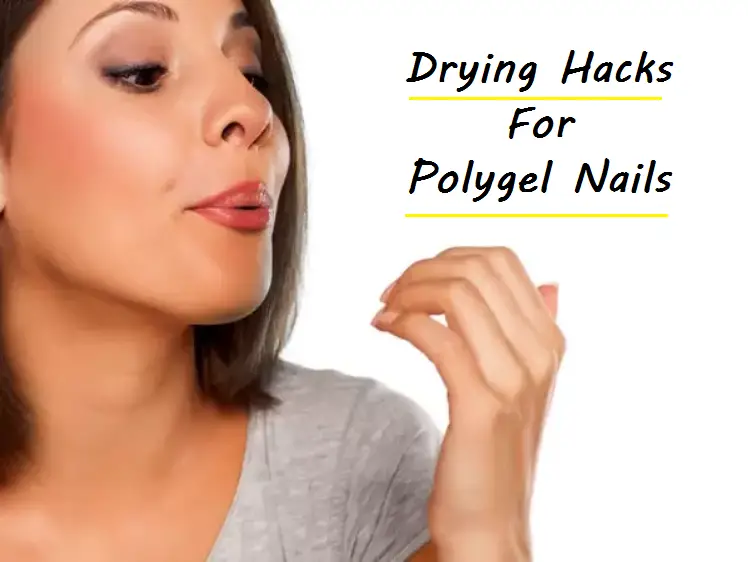There is a lot of misinformation spreading on the internet regarding the drying technique of polygel nails. Being a nail tech, I thought of debunking every one of them.
So, here in this article, I have answered minutely all the possible questions a beginner usually has while drying polygel nails.

To know how to dry polygel nails, you need to at least have some idea about what polygel is.
Polygel Composition:
Polygel is a real mix of hard gel and acrylics explicitly made for nail professionals. Acrylic nail extensions and Polygel nails are frequently contrasted.
Polygel is a solution that supports all nail stylists, including acrylics and gel systems while removing the problematic concerns as needed.
In other words, Polygel is neither an acrylic nor a hard gel; instead, it effectively combines the advantages of both in a single unique solution that is undoubtedly superior!
PolyGel, unlike hard gel, does not level on its own and instead stays set. If you have a Polygel nail kit that does not include a UV lamp and wonder if you can air dry Polygel without the need for a UV light, this article will explain whether you can and how you can do it.
After all, if you want your Polygel enhancements to be firm and remain on your nails, they must be thoroughly dried. So let’s get started.
Does Polygel Dry On Its Own?
PolyGel, unlike hard gel, does not self-level and stays put; unlike acrylics, it does not harden until cured under an LED or UV lamp.
You can cure Polygel nails without UV radiation; however, an LED light is an alternative. So far, there is insufficient evidence that cold water, solar rays, or perhaps even air will suffice.
Some individuals believe that you can heal your fingernails with sunlight or ice water, but this treatment is unlikely to work, and professionals advise against it.
You can dry regular nail paint in the sun, cold water, or hairdryer.
There are a variety of alternative techniques to hasten the drying time of ordinary nail polishes, but this is not the case with Polygel paints. As a result, if you want something which will dry on its own, regular nail polish will suffice.
Can Polygel Nails Air Dry?
Polygel Nail paints have grown in popularity due to their fast drying rate and long wear duration.
While Polygel paint can maintain your nails looking excellent for weeks, using a UV light to cure the varnish might be harmful to your health.
Although Polygel does not dry by itself, other techniques to cure it need low UV exposure.
While only a LED light can cure your polish as rapidly and efficiently as a UV light, other methods like using a non-UV Polygel polish, adding a drying agent, or immersing your nails in ice water may work, but not as well.
How Long Does It Take For Polygel To Dry?
Apply a UV or LED bulb to your nails. The Polygel will cure in 30 seconds with an LED bulb or 2 minutes with a UV lamp. It’s possible to over cure Polygel.
When Polygels are over-cured, some may discolor and lose their shine, while others will do neither or both. The Polygel and the curing light play a significant role in this.
Each producer should tell the nail technician what problems they can encounter if they over-cure the product.
Ways To Dry Polygel Without UV Light?
On newly painted nails, use a fast-drying nail polish spray. Place one of your palms on a flat surface that you have coated with paper towels or newspapers.
While the Polygel is still wet, hold the can of quick-drying polish spray approximately 6 inches (15 cm) distant from your hands and spritz a light layer over your nails.
Spray the nails with your other hand in the same way. Allow several hours for your nails to dry.
Wash both your hands with soap and warm once the polish has dried and hardened to remove any remaining spray. While quick-drying sprays are for non-gel nail polishes, they may nonetheless aid in the curing of Polygel lacquer.

An LED lamp is the only way to cure Polygel perfectly without using a UV lamp. LED lights are currently the only UV lamp alternative available on the market.
UV lamps include UV light bulbs that release UV rays, which cause photopolymers in Polygel to solidify. On the other hand, LED lights feature several LEDs that emit UV rays.
These UV beams are ideal for curing Polygel. Polygel is cured much faster with an LED bulb than with a UV lamp.
A UV light takes 120 seconds to cure Polygel, but most LED lamps only take 60 seconds to cure Polygel of any consistency or color. Just make sure the device has at least 36 watts of electricity.
The higher the wattage, the faster the Polygel will cure. Less powered units will cure Polygel, but this will take longer.
You should not avoid high-power units because Polygel nearly never creates heat surges during the curing process.

LED lights have become such an excellent and popular replacement to UV lamps that UV light bulb units have mostly been replaced.
A few years ago, some UV-curable gel nail paints and builder gels were available. UV lamps emit a broader range of UV frequencies than LED units, and these polishes were outside of the LED-curable range.
However, practically all current products are LED-curable, thanks to a reformulated recipe. LED devices are more portable and easy to operate. That’s why utilizing an LED light instead of a UV lamp is ideal for curing Polygel.
How Long Does It Require For Polygel Nails To Dry Without UV Light?
If you want to avoid using UV lamps for safety reasons, another option is to use an LED nail lamp to cure gel nails. It is the only option that will dry Polygel in the same way. Without using UV or LED lamps, Polygel will take hours, if not days, to cure.
How To Dry Polygel Without UV Light?
Make Sure Your Nails Are Ready
Push the cuticles back, and file down lengthy nails slightly. Remove any prior coatings, such as acrylics or gel nail paint. Hands should be washed and dried entirely or sanitized. To erase shine, lightly buff the nail’s surface. Clean the nail plate to eliminate any filing dust. A nail dehydrator removes natural oil and humidity from the nail. To increase the adhesion of your Polygel manicure, use a nail primer.
Start By Applying The Base Coat
Apply one layer of Polygel base coat and cure for 30 seconds under LED/UV light. If your light has one, use a minimal wattage setting to avoid heat spikes. After curing, don’t wipe away the stickiness.
Use Polygel
Put Polygel to your nail by squeezing it from the tube, or distribute it over the dual form and put the form to your nail.
Cure It With An LED Light
Place your hand beneath the bulb and set the timer to 60 secs. Wait for the Polygel to dry after placing the hand underneath the lamp for 60 seconds. Usually, you will feel no heat spikes. If your light is weak and the Polygel hasn’t entirely dried, give it another 30-60 seconds to cure. Remove the dual form from your Polygel nails and file and buff them to perfection.
Apply The Final Layer Of Paint
Apply one coat of your preferred top coat and cure it under the lamp for 30-60 seconds. If necessary, wipe away the sticky coating.
You’ve completed the task!
Conclusion
Polygel is the ideal alternative to artificial nails for building, volumizing, and shaping the bottom of the nail. Consider it an excellent basis for any gel manicure. It does not harm or destroy your nails. Don’t worry about damaging your natural nails if they’re applied and removed correctly. A Polygel manicure may last up to three weeks with proper care and application.
More Articles On Polygel:
- How To Do Polygel Nails With Tips?
- Polygel Vs Builder Gel – All You Need To Know
- Detailed Guide On Polygel Slip Solution Substitute
- How To Do Polygel Nails With Dual Forms?
- Can You Use Polygel Nails Without a UV Light?
- Can You Use Polygel On Bitten Nails?








